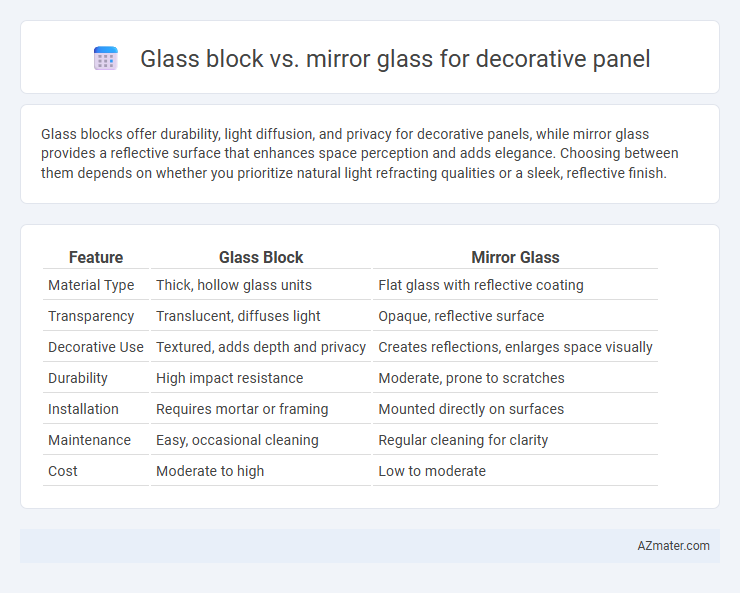Glass blocks offer durability, light diffusion, and privacy for decorative panels, while mirror glass provides a reflective surface that enhances space perception and adds elegance. Choosing between them depends on whether you prioritize natural light refracting qualities or a sleek, reflective finish.
Table of Comparison
| Feature | Glass Block | Mirror Glass |
|---|---|---|
| Material Type | Thick, hollow glass units | Flat glass with reflective coating |
| Transparency | Translucent, diffuses light | Opaque, reflective surface |
| Decorative Use | Textured, adds depth and privacy | Creates reflections, enlarges space visually |
| Durability | High impact resistance | Moderate, prone to scratches |
| Installation | Requires mortar or framing | Mounted directly on surfaces |
| Maintenance | Easy, occasional cleaning | Regular cleaning for clarity |
| Cost | Moderate to high | Low to moderate |
Introduction to Decorative Panels
Decorative panels utilize materials like glass blocks and mirror glass to enhance interior aesthetics and light distribution. Glass blocks provide textured translucency and structural durability, making them ideal for privacy and design depth in walls. Mirror glass offers reflective surfaces that create an illusion of expanded space and amplify natural light, perfect for modern, sleek panel applications.
What Are Glass Blocks?
Glass blocks are thick, translucent units made from molded glass that provide both privacy and natural light diffusion in decorative panels, commonly used in architectural designs and interior partitions. They offer structural strength and insulation properties, which make them suitable for both exterior and interior applications compared to mirror glass, which primarily serves an aesthetic function by reflecting light and space. Glass blocks enhance ambiance while maintaining privacy, making them a functional choice for decorative panels where light transmission and durability are priorities.
What Is Mirror Glass?
Mirror glass is a reflective glass panel coated with a thin metallic layer, commonly silver or aluminum, creating a highly polished surface that reflects light and images with clarity. Unlike glass blocks, which provide translucency and texture, mirror glass offers a sleek, smooth finish ideal for enhancing light and creating a sense of space in decorative panels. Its ability to reflect surroundings makes mirror glass a popular choice for modern interior design, combining functionality with aesthetic appeal.
Aesthetic Appeal: Glass Block vs Mirror Glass
Glass blocks offer a textured, three-dimensional aesthetic that diffuses light while providing privacy, enhancing the ambiance with a subtle, artistic glow. Mirror glass creates a sleek, reflective surface that visually expands space and adds a modern, elegant touch with high light reflectivity. Choosing between glass block and mirror glass depends on desired light interaction and design style, with glass blocks favoring softness and translucency, and mirror glass emphasizing clarity and brightness.
Light Transmission and Illumination
Glass blocks offer higher light transmission with diffused illumination, creating a soft, natural glow ideal for privacy while still allowing daylight to penetrate interior spaces. Mirror glass panels reflect light intensely, enhancing brightness and creating the illusion of larger space but provide no transparency or actual light passage. Choosing between glass block and mirror glass depends on the desired balance between light diffusion and reflective illumination in decorative panel applications.
Privacy Features: Comparing Both Options
Glass blocks provide excellent privacy due to their textured, translucent surface that obscures visibility while allowing light to pass through, making them ideal for bathrooms and entrance areas. Mirror glass offers limited privacy since it reflects the environment but can be see-through from the opposite side depending on lighting conditions, often requiring additional treatments like films or curtains. For maximum privacy in decorative panels, glass blocks outperform mirror glass by combining light diffusion with visual blockage.
Durability and Maintenance
Glass blocks offer exceptional durability due to their thick, solid structure that resists impact, moisture, and temperature changes, making them ideal for long-lasting decorative panels. Mirror glass, while providing a sleek, reflective finish, is more prone to scratches, staining, and requires frequent cleaning to maintain its appearance. Maintenance of glass blocks involves minimal effort with occasional wiping, whereas mirror glass demands regular polishing and careful handling to avoid damage and preserve clarity.
Installation Considerations
Glass block installation requires precise alignment and mortar application to ensure structural stability and consistent spacing, often necessitating professional expertise and additional framing support. Mirror glass panels offer simpler installation with adhesive backing or mounting clips, allowing for quicker and more flexible placement but requiring careful handling to avoid scratches and ensure even surfaces. Both materials demand moisture-resistant seals and proper surface preparation to maintain durability and aesthetic appeal in decorative panels.
Cost Comparison: Glass Block vs Mirror Glass
Glass block panels typically cost between $50 to $100 per square foot, offering durability and a textured aesthetic, while mirror glass panels range from $30 to $80 per square foot, providing a sleek, reflective surface. Installation expenses for glass blocks are generally higher due to their weight and specialized labor, whereas mirror glass installation tends to be quicker and less labor-intensive, reducing overall costs. Maintenance costs favor mirror glass, as it is easier to clean, whereas glass blocks require more effort to maintain their appearance over time.
Best Applications for Each Material
Glass block is ideal for decorative panels in bathrooms, entryways, and facades due to its ability to provide natural light diffusion while maintaining privacy and offering strong structural support. Mirror glass excels in interior design applications such as feature walls, dressing rooms, and living spaces where reflection, light enhancement, and a sense of expanded space are desired. Both materials serve distinct aesthetic and functional purposes; glass block emphasizes translucency and privacy, while mirror glass prioritizes reflectivity and visual amplification.

Infographic: Glass block vs Mirror glass for Decorative panel
 azmater.com
azmater.com